Art & Culture Beat in Oslo
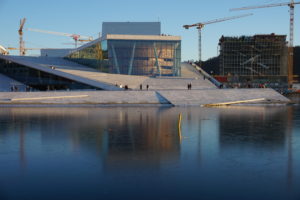 It started with Oslo’s award-winning Opera House which takes up over 400,000 square feet and is designed in the shape of an iceberg! From the exterior, the white and metal facade is imposing, fierce, cold. But as you enter, the polished oak wood paneling warms you, as does the sunlight beaming through floor to ceiling windows. As our guide Lena, a past dancer with the National Ballet, explained, the design was three years in the making. There are over 50 artists and/or craftsman involved in any given production, and all 50 groups were consulted and had input in the design of the opera house.
It started with Oslo’s award-winning Opera House which takes up over 400,000 square feet and is designed in the shape of an iceberg! From the exterior, the white and metal facade is imposing, fierce, cold. But as you enter, the polished oak wood paneling warms you, as does the sunlight beaming through floor to ceiling windows. As our guide Lena, a past dancer with the National Ballet, explained, the design was three years in the making. There are over 50 artists and/or craftsman involved in any given production, and all 50 groups were consulted and had input in the design of the opera house.
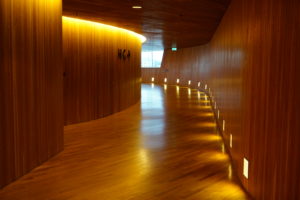 Every aspect of the interior design was made for acoustics, including the wood paneling, the chandelier, and even the upholstery on the chair cushions (no two are alike!) The acoustics are so good that the performers never wear microphones. As we sat in the upper balcony of the main stage, we could clearly hear the conversations of the workers setting up for the evening’s performance! Lena toured us through the ballet studio, the costume workshop as well as Ballerina Alley – where the dressing rooms of the ballerinas are. The finale was trip on stage where we had a behind-the-scenes view of what went on backstage.
Every aspect of the interior design was made for acoustics, including the wood paneling, the chandelier, and even the upholstery on the chair cushions (no two are alike!) The acoustics are so good that the performers never wear microphones. As we sat in the upper balcony of the main stage, we could clearly hear the conversations of the workers setting up for the evening’s performance! Lena toured us through the ballet studio, the costume workshop as well as Ballerina Alley – where the dressing rooms of the ballerinas are. The finale was trip on stage where we had a behind-the-scenes view of what went on backstage.
I scored a ticket a ticket to the performance of the Nutcracker for that night – the very last ticket available. It was only the second year of this particular interpretation. It was absolutely magical and magnificent. The choreography was outstanding and the costumes were amazing. Having done the tour and having seen them lined up for dressing, it was a thrill to see them on stage.
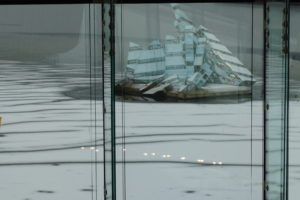
Outside, the roof of the building angles to ground level, creating a large plaza that invites pedestrians to walk up and enjoy the panoramic views of Oslo. It was intended to be used as a recreational area, the only opera house in the world where you can walk on the roof! Floating in front of it a glass, concrete and stainless steel statue by and Italian artist. It is free standing – rather free floating – as it is not moored in place and it moves around with the tide and currents.
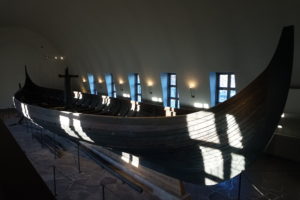 The Viking Ship Museum, which houses three Viking ships used for burial purposes, was on my art & culture beat and a great find. The Tune ship was the first Viking ship to be excavated (1867) and is still one of the best preserved Viking ships in the world. Following, in the Autumn of 1879, was the discovery of the Gokstad. And then in 1903, the Oseberg was discovered by a farmer who had dug into a large burial mound on his property and had come across the remains of a ship. Always fascinated by burial rituals, it amazed me that one or two bodies were placed in these ships and then the entire ship was buried in the ground!
The Viking Ship Museum, which houses three Viking ships used for burial purposes, was on my art & culture beat and a great find. The Tune ship was the first Viking ship to be excavated (1867) and is still one of the best preserved Viking ships in the world. Following, in the Autumn of 1879, was the discovery of the Gokstad. And then in 1903, the Oseberg was discovered by a farmer who had dug into a large burial mound on his property and had come across the remains of a ship. Always fascinated by burial rituals, it amazed me that one or two bodies were placed in these ships and then the entire ship was buried in the ground!
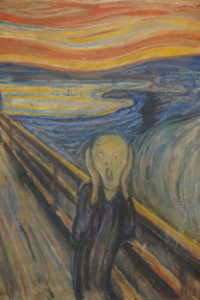 The National Gallery’s permanent exhibition “The Dance of Life – The collection from antiquity to 1950” was outstanding. It comprises various genres, artists and periods and I was able to enjoy the European Impressionists, the Modernists as well as the Masters. Most interesting was learning about Edvard Munch, his life and his work. It has been my mission through my travels to appreciate at least one local artist in the countries that I visit. Last year it was Klimt in Austria and this year it is Munch in Norway. It was an honour to see Munch’s most popular version (one of four) of The Scream at the National Gallery.
The National Gallery’s permanent exhibition “The Dance of Life – The collection from antiquity to 1950” was outstanding. It comprises various genres, artists and periods and I was able to enjoy the European Impressionists, the Modernists as well as the Masters. Most interesting was learning about Edvard Munch, his life and his work. It has been my mission through my travels to appreciate at least one local artist in the countries that I visit. Last year it was Klimt in Austria and this year it is Munch in Norway. It was an honour to see Munch’s most popular version (one of four) of The Scream at the National Gallery.
There was so much that was left unseen . . . which just leaves an excuse for a return trip!

